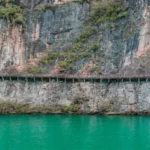Ruli is one of the larger settlements of descendants of Zhu Xi, a prominent philosopher and educator of the Southern Song Dynasty, in Jiangsu. Currently, it is home to over 4,400 residents with the surname Zhu, along with 40% of residents with other surnames. In the past two centuries, more than a thousand descendants of the Zhu family have migrated to various parts of the Yangtze River basin and overseas.
Now under the jurisdiction of Yaoqiao Town in Zhenjiang New District, Ruli has become a major administrative village. In fact, seven hundred years ago, this area was a desolate beach adjacent to the site of Duan Shandun, a settlement from the Shang Dynasty (Huashan Ji). It wasn’t until the fifth year of the Zhi Yuan era in the Yuan Dynasty (1339 AD), when Zhu Wen Tong, the eighth generation descendant of Zhu Xi and a prosecutor in Shandong, chose to settle here after an official trip to Dan Tu. He reclaimed land, cultivated fields, and multiplied his descendants, leading to the area being known as ‘Weili’. Over time, as the Zhu family grew, it became known as ‘Zhu Jia Wei’. The residents of this area have always valued farming and reading, with some venturing out to trade, often in tobacco shops and sauce gardens. By the late Ming and early Qing dynasties, more and more young people from Ruli were becoming officials, leading to a surge in the village’s reputation. It is said that Emperor Qianlong renamed it ‘Ruli’, meaning ‘the place where the descendants of the literati reside, the old home of the Confucians’. Since then, the ancestral hall was expanded, the market was tidied up, and the old town market began to take shape. The streets form a ‘T’ shape, with a horizontal street in the south and north, and a vertical street in the west. Near the intersection point to the north, there are two archways spanning the street. This ‘T’ street is known as the ‘Old Street’. In contrast, a new cement road has been built in recent years, connecting with the west street, stretching three kilometers, and is called the ‘New Street’. It connects Danyang Houxiang in the south to Zhenjiang Yaoqiao in the north, with markets and Western-style buildings lining the route, beginning to show the style of a modern market. Seventy years ago, Ruli’s Old Street was very prosperous. The horizontal street is about 400 meters long, and the vertical street about 276 meters, with the entire street paved with slabs of hemp stone, and under the stones, there are underground waterways (now changed to cement). At the end of the south street, there is a century-old locust tree, under which is the old residence of ‘Sande Hall’, a complex of Qing Dynasty architecture. At the end of the north street, there is ‘Yeshuyuan’, a place where the clan elders would discuss matters and relax. ‘Yanchitang’, according to legend, is where ancient scholars would gather to wash their writing brushes and ink slabs. There was a saying, ‘Spring tide does not reach Yanchitang’. If the first tide of spring could flow into this pond, then Ruli would produce a ‘Zhuangyuan’ (top scholar). Near the intersection point of the north street, the two ‘archways’ are the symbolic buildings of the old town. Both archways have inscribed plaques with the characters ‘Ruli’, said to be inscribed by Emperor Qianlong, the southern one being stone carving, and the northern one being brick carving. Between these two archways, there is the Zhu family ancestral hall, which has been preserved for over three hundred years since its expansion in the Qing Dynasty (its predecessor was a hall built in the early Ming Dynasty with six rooms, two courtyards, and two side rooms), known as the ‘Old Ancestral Hall’. It covers an area of 1200 square meters and is of Huizhou architectural style. Every spring and autumn, the eight major branches of the Zhu family gather here to hold solemn sacrificial ceremonies. With large incense and candles, whole pigs and sheep, three kneelings and nine prostrations, four risings and four bowings, the clan members in red-top hats, long robes, and horse coats, parade and worship in the music.During the Chinese New Year’s Eve and Lantern Festival, the ancestral halls are adorned with colorful lanterns and decorations, attracting a tide of visitors from both genders to enjoy the festive atmosphere. The specific opening hours and business status are subject to the actual conditions on the day.









